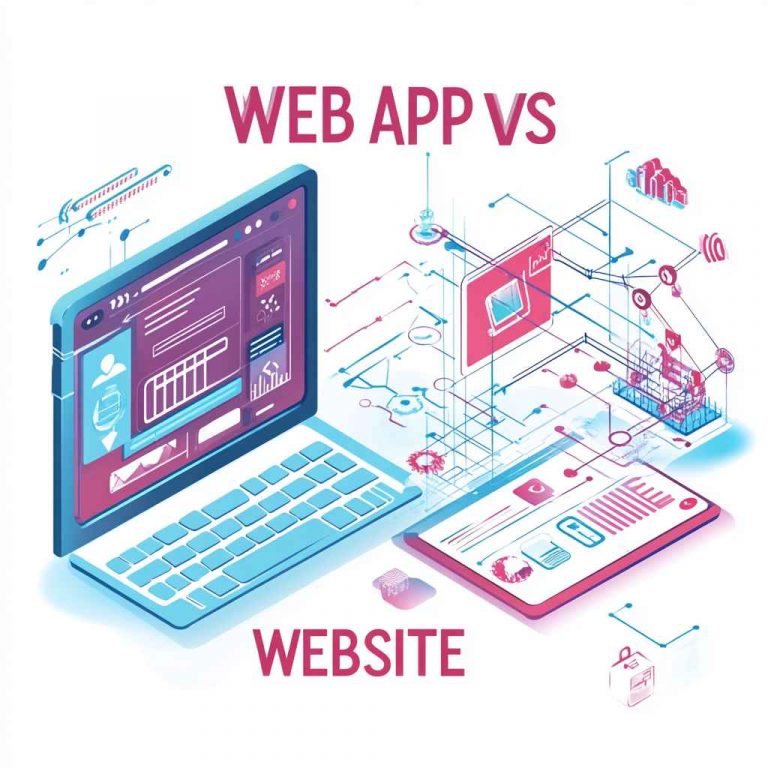As a business, sooner or later you face a crucial decision when establishing your online presence: web apps vs websites. This choice has a significant impact on user experience, functionality, and overall business success. Understanding the key differences between these two options is essential to make an informed decision that aligns with your company’s goals and resources.
As you navigate this decision-making process, you’ll need to consider various factors. These include your business objectives, development requirements, maintenance needs, and integration capabilities. By examining these aspects, you’ll gain insights into which option – a web app or a website – is better suited to your specific needs. This comparison will help you determine the most effective way to reach your target audience, deliver your services, and grow your online presence.

When deciding between web apps and websites, it’s crucial to align your choice with your business objectives. Let’s explore how different goals can guide your decision.
If your primary aim is to spread educational content or company details, a website will suffice. Websites are typically informational in nature, making them ideal for blogs and news sites. They provide a simple and accessible platform for users to learn about your business, including descriptions, upcoming events, and contact information.
For businesses looking to foster deeper connections with customers, a web app might be the better choice. Web apps offer a more interactive experience, allowing users to manipulate data and request different information. This creates a dialog between the user and the business, enabling features like electronic payments, online chats, and document downloads.
Mobile apps, in particular, can leverage device features and collect user data to offer tailored experiences. They can send personalized push notifications, track user behavior, and provide recommendations based on individual preferences. This level of customization can create a deeper connection with users, leading to increased engagement and loyalty.
If you’re running an online shop, a web app can provide the necessary functionality. Web apps allow users to buy items and search through catalogs. They can integrate with Customer Relationship Management (CRM) systems, helping you store customer data, order information, and improve sales team performance.
However, if your goal is to reach as many potential customers as possible, a mobile website might be more suitable. Its accessibility across all devices and platforms ensures that anyone with an internet connection can browse your products and make purchases.

Web apps excel in data collection and analysis. They can utilize user data and analytics to customize each customer’s content, recommendations, and functionality, resulting in a more personalized and immersive experience. For businesses looking to gather and analyze data efficiently, incorporating web scraping techniques can be advantageous, allowing you to extract critical market insights and consumer trends.
By carefully considering these factors in relation to your business goals, you can make an informed decision between web apps and websites, ensuring that your chosen platform aligns with your objectives and supports your growth strategy. An important thing to keep in mind is also your privacy policies when it comes to data collection. The EEA has new and strict requirements when it comes to the user’s consent to collect their data. One such important policy is the Digital Markets Act (DMA) and the corresponding data collecting initiative from Google, the Consent mode V2.
When it comes to the initial development process, web apps and websites differ significantly. Web apps require both frontend and backend development, databases, privacy and security measures, and more. This complexity often necessitates a team of developers and designers, along with servers and hosting solutions.
For web apps, we usually recommend you hire a team of web development experts who will help you bring your ideas to life.
Maintaining web apps typically involves regular updates, bug fixes, and feature enhancements. This ongoing process is crucial for keeping your application functional, safe, and bug-free. You should never stop optimizing performance, reacting to user feedback, renewing licenses, and extending functionality.
For websites, maintenance can be simpler. You can edit individual files after deployment without recompiling, which means changes take effect immediately. However, this approach might cause compilation errors or crashes when pages are called for the first time.
The team requirements for web apps and websites can vary. Web apps often need skilled developers for ongoing maintenance. However, with no-code platforms, even a single founder working part-time can develop a web app in a matter of months.
For websites, especially those built with content management systems, one developer can often be responsible for creating and managing the entire site.
Generally, web application development is more costly than building a website due to its complexity. However, the cost can vary depending on the type of web app you’re building, such as Multi-Page Applications (MPAs), Single-Page Apps (SPAs), or Progressive Web Apps (PWAs).
Factors influencing cost include functionality, design complexity, development approach (freelance, outsourcing, or in-house), and geographical location of developers. Post-release expenses, including bug fixing and maintenance, typically account for 20-25% of the initial development budget annually.
To manage costs, consider starting with a Minimum Viable Product (MVP) to validate your idea before investing in full-scale development. You can also use third-party tools and APIs to add valuable features without building everything from scratch.

When it comes to integration capabilities, web apps generally offer more robust options compared to websites. This enhanced integration allows for a more interactive and dynamic user experience.
Web apps excel at integrating with third-party services, providing a wide range of functionalities. For instance, an e-commerce web app can seamlessly integrate with your Customer Relationship Management (CRM) system to automatically collect user data. This integration enables you to analyze customer behavior and buying patterns, allowing you to offer personalized experiences.
While websites can also integrate with CRMs, this integration is typically not their core functionality. Websites mainly use CRM integration for personalized content delivery rather than providing tailored user journeys.
Application Programming Interfaces (APIs) play a crucial role in web app integration. They allow different software applications to communicate and interact with each other. Web apps can leverage APIs to:
APIs also facilitate the decoupling of front-end and back-end components in web applications, making it easier to update and scale each component independently.
Integrating social media features into your web app can significantly enhance user engagement and expand your reach. Some benefits include:
By incorporating authentic social features, you can add real value to your users’ experience.
For e-commerce web apps, integrating payment gateways is essential. APIs from payment service providers allow for secure transaction processing within your application. This integration enables you to offer a seamless checkout experience, handling tasks such as payment processing, tax calculations, and maintaining PCI compliance.
By leveraging these integration capabilities, you can create a more powerful, interactive, and user-friendly web application that meets your business goals and enhances user experience.

The choice between web apps and websites has a significant impact on a business’s online presence and user engagement. Both options offer unique benefits and challenges, making it crucial to align your decision with your specific business goals and resources. To make the right choice, it’s essential to consider factors such as your target audience, desired functionality, development capabilities, and long-term maintenance requirements.
In the end, whether you opt for a web app or a website, the key is to create a user-friendly and effective online platform that meets your business needs. By carefully weighing the pros and cons of each option and considering your company’s objectives, you can make an informed decision that sets the stage for your digital success. Remember, the digital landscape is always evolving, so staying flexible and open to new technologies and approaches is crucial to maintain a competitive edge in the online world.
© 2024 Created by RoakonTerms and conditions